Mastigoteuthidae
Mastigoteuthis
Whip-lash squid
Michael Vecchione, Richard E. Young, and Annie Lindgren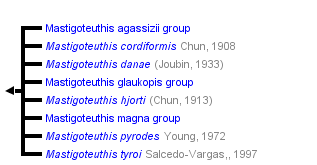


This tree diagram shows the relationships between several groups of organisms.
The root of the current tree connects the organisms featured in this tree to their containing group and the rest of the Tree of Life. The basal branching point in the tree represents the ancestor of the other groups in the tree. This ancestor diversified over time into several descendent subgroups, which are represented as internal nodes and terminal taxa to the right.

You can click on the root to travel down the Tree of Life all the way to the root of all Life, and you can click on the names of descendent subgroups to travel up the Tree of Life all the way to individual species.
For more information on ToL tree formatting, please see Interpreting the Tree or Classification. To learn more about phylogenetic trees, please visit our Phylogenetic Biology pages.
close boxIntroduction
Mastigoteuthids are deep water pelagic or benthopelagic squids that are morphologically distinctive. They are weakly muscled, reddish in color and have elongate fourth arms and whip-like tentacular clubs. Much of the red pigment is not in chromatophore organs but dispersed in other integumental cells, although chromatophores are present. The Mastigoteuthidae, however, is among the most taxonomically confused families of all deep-sea squid due to the fact that many characters are based on the structures (tentacles and skin photophores) often lost during capture.
The whip-like tentacles have tentacular clubs that are little differentiated from the tentacular stalks eventhough they are covered with thousands of minute suckers. In some species, the suckers are so small as to be invisible to the naked eye. The photograph below shows the midregion of a tentacular club with the sucker-bearing portion marked by an X. The arrow points to a microscope enlargment showing the small suckers. Such small suckers, at least in freshly dead specimens, seem to function much like "fly paper" in that anything touching them, whether large or small, sticks.

Figure. Side view of a portion of the tentacle club (bottom) of Mastigoteuthis sp A, Hawaiian waters, showing the club covering the top half of the cyclindrical tentacle. Insert - Portion of the club, marked by an "X", as seen through a microscope. Photographs by R. Young.
Histological sections through the tentacle can be seen here.
Fins are usually very large and positioned mostly posterior to the muscular part of the mantle. No well-developed system of giant nerve fibers is present, which reflects the absence of rapid jet propulsion (Dilly, et al., 1977).
Brief diagnosis:
Member of the chiroteuthid families ...- with arms IV longest.
- with cyclindrical, whip-like tentacular clubs bearing small suckers in numerous irregular series.
- with oval funnel locking-apparatus usually bearing various knobs or lobes (tragus and antitragus) affecting the shape of the groove.
Characteristics
- Arms
- Arms IV longest, thickest and with expanded lateral membranes which form tentacular sheaths which can envelope entire contracted tentacles.
- Tentacles
- Tentacular clubs elongate, virtually cylindrical; with suckers in many irregular series (30 or more in some species).
- Head.
- Funnel
- Funnel locking-apparatus oval, usually with knobs (tragus, antitragus) affecting the shape of the depression in the funnel component that often varies between species.
- Fins
- Fins large (ca. 50% of ML) to very large (ca. 90% of ML).
- Fins with terminal position.
- Tail
- Short tail present (often absent due to damage during capture).
- Tail supported by secondary conus.
- Photophores
- Photophores present on eyeball or eyelid and/or integument or absent.
Comments
Species and species groups in the Mastigoteuthidae
- M. agassizii group: M. agassizii (Atlantic), M. dentata (IndoPacific), M. psychrophila (Antarctic and adjacent waters).
- M. cordiformis (West Pacific).
- M. glaukopis group: M. atlantica (Atlantic), M. famelica (N. E. Pacific), M. glaukopis (Indian).
- M. hjorti (circumglobal).
- M. magna group: M. magna (Atlantic), Mastigoteuthis sp. A (tropical Pacific), Mastigoteuthis type beta (subantarctic Pacific).
- M. pyrodes (North Pacific).
- M. danae (Atlantic, Indian) M. tyroi (Indian): These are known only from paralarvae that probably represent the young of known species.
The following table compares species/species-groups.
| Funnel pocket* | Funnel locking- apparatus* | Integumental photophores* | Eyeball photo- phores | Eyelid photo- phores* | Chromato- phores** | Tubercules in subadults | |
| M. agassizii group | Yes | Ear shaped | Yes | No | Tiny | Scattered | No |
| M. cordiformis | No | Ear shaped | No | No | No | Abundant | Yes |
| M. glaukopis group | Yes | Ear shaped | No | No | Large | Abundant | No |
| M. hjorti | No | Oval | No | Yes | No | Abundant | Yes |
| M. magna group | No | Flask shaped | No / microscopic | No | No | Abundant/absent? | No |
| M. pyrodes | Yes | Ear shaped | Yes | No | Medium | Abundant | No |
*Funnel pocket (arrow) extends between funnel bridles deep into the head to the cephalic vein. Presence of the pocket can be recognized in the paralarval stage onward (at least in M. famelica).
*Funnel locking-apparatuses have three major forms.
*Integumental photophores are of three types. Those of the M. agassizii-group (below left) and M. pyrodes (below middle) look superficially the same. Those of Mastigoteuthis sp. A (below right, a member of the M. magna-group) are much smaller and very difficult to see (in the photograph they are apparent since most of the covering chromatophore-bearing skin has been lost during capture.
*Eyelid photophores (arrows) occur in three sizes. Compare Small and Medium sizes with the size of the nearby integumental photophores. Species with Large eyelid photophores lack integumental photophores.
**Chromatophores. See photographs of integumental photophores above. Count the number of chromatophores between photophores in M. agassizii and in M. pyrodes to see the difference between "scattered" and "abundant" chromatophores. See the M. agassizii-group page to compare the integument of these two species.
Discussion of Phylogenetic Relationships
The M. agassizii-, M. glaukopis- and M. magna-groups each contain species that are very closely related. The position of M. pyrodes is uncertain, but it may be closest to the M. agassizii-group and the M. glaukopis-group as they all share a funnel pocket (this feature, however, is probably a pleisiomorphy) and an eyelid photophore. The presence of integumental photophores over much of the ventral surfaces may indicate closer relationship to the M. agassizii-group, but the structure of the photophores has not been examined in M. pyrodes, and they superficially appear to be different from those of the M. agassizii-group. All the above species share long, slender clubs with sucker orifices dominated by pegs on the outer ring and not teeth on the inner ring. M. cordiformis and M. hjorti show many similarities (absence of funnel pocket and skin photophores, relatively short tentacular clubs with large suckers whose orifices are dominated by teeth on the inner rings, large fins, virtuallly identical skin tubercules in adults) and probably have a common ancestor. However these two species are very distinct and not nearly as similar to one another as are those species placed in the three species-groups. Species in the M. magna-group have uncertain relationships based on morphology. They are similar to M. cordiformis and M. hjorti in the absence of a funnel pocket but have tentacles more similar to the other species in the genus.
Molecular data are available for only a few species in the family. A phylogenetic analysis based on three genes from the four species for which molecular data are available (see tree below) and using a related species, Joubiniteuthis portieri, as the outgroup yielded a single tree (L= 515, CI= 89, RI= 90) (Young et al. submitted, see below). These limited data suggest that M. hjorti may be the closest relative of the M. magna-group.

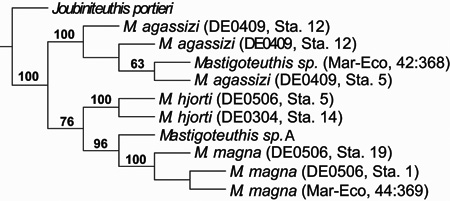
Figure. Phylogenetic analysis of the combined data (COI, 16S, 12S). Numbers in bold above branches indicate jackknife support values above 50%.
©
The Mastigoteuthidae includes many poorly known species, some described only from paralarvae. This situation and the disagreement in the classification of Salcedo-Vargas (see next section) with that presented here suggest that modifying the classification is premature and should wait until our knowledge has increased to the point where a full phylogenetic study can be made. We recognize, therefore, only the single genus Mastigoteuthis.
Details on the squid that provided the molecular data can be found here.
Nomenclature
Salcedo-Vargas and Okutani (1994) proposed a generic and subgeneric classification based on actual or presumed morphological similarity. Considerable modification of this classification subsequently was proposed by Salcedo-Vargas (1997) and formal subgeneric names were dropped. His 1997 classification is as follows:
Idioteuthis Sasaki, 1916????- Group A: I. cordiformis, I. latipinna
- Group B: I. hjorti, I. okutanii
- Group C: I. famelica, I. danae, I. tyroi
- Group A: M. inermis, M. magna
- Group B: M. agassizii, M. grimaldii, M. pryodes, M. dentata*
- Group C: M. glaukopis, M. atlalntica, M. iselini*, M. psychrophila*
The recognition of some species and the above alignment of species differs considerably from that presented here.
A list of all nominal genera and species in the Mastigoteuthidae can be found here. The list includes the current status and type species of all genera, and the current status, type repository and type locality of all species and all pertinent references.
Species of doubtful validity or uncertain status are described here. These species are: Mastigoteuthis latipinna, Mastigoteuthis islini, Mastigoteuthis inermis, Mastigoteuthis okutanii and Chiroteuthoides hastula.
Behavior
Two species (M. hjorti, M. magna) have been observed from submersibles drifting just above the ocean floor with tentacles dangling within a few mm of the bottom, presumably, to capture copepods and other small plankters of the epibenthic zooplankton (Roper and Vecchione, 1997). The tentacles extend from the tips of the ventral arms (arms IV) from where they reside in the tentacular sheaths (i. e., between the arms and their lateral membranes). The tentacles are typically held apart by the ventral arms (the "tuning fork" posture) so they "fish" independently of each other (Roper and Vecchione, 1997). AVI and MPEG formated video clips of this behavior is available at Cephalopods in Action.

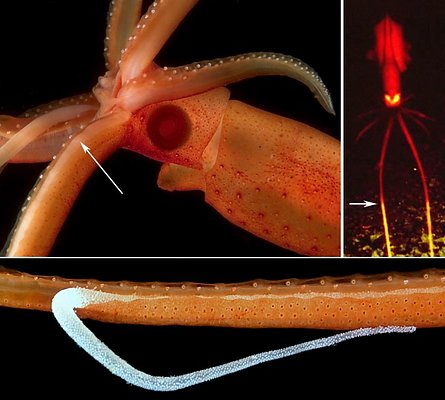
Figure. Left top - Side view of the head and brachial crown of M. agassizii. Arrow points to the tentacle base neatly enveloped by the lateral membrane of arm IV. Photograph by David Shale. Right top - Ventral view of Mastigoteuthis sp. hanging in the water just above the ocean floor, submersible photograph, Hawaiian waters. The arrow points to the place where the tentacle emerges from the tentacular sheath of the left arm IV. Photograph modified from Young, et al. (1999), courtesy of the Hawaii Undersea Research Laboratory. Bottom - Dorsal view of a portion of a ventral arm (arm IV) of M. agassizii with the tentacle (white) mostly hidden within the tentacular sheath. The entire length of the tentacle apparently can be held within the tentacular sheath. Photograph by David Shale. Views of M. agassizii were photographed in a shipboard aquarium by David Shale on an NSF cruise with Marsh Youngbluth, Harbor Branch Oceanographic Institution, N.E. Atlantic waters. The brilliant red color in both images has been reduced in Photoshop to accentuate detail. ©
References
Dilly, P. N., M. Nixon and J. Z. Young. 1977. Mastigoteuthis--the whip-lash squid. J. Zool., Lond., 181: 527-559.
Nesis, K.N. 1977. Mastigoteuthis psychrophila sp. n. (Cephalopoda, Mastigoteuthidae) from the Southern Ocean. Zoologichesky Zhurnal, 65(6):835-842.
Roper, C. F. E. and M. Vecchione, 1997. In-situ observations test hypotheses of functional morphology in Mastigoteuthis (Cephalopoda, Oegopsida). Vie Milieu 47:87-93.
Salcedo-Vargas, M. A. and T. Okutani. 1994. New classification of the squid family Mastigoteuthidae (Cephalopoda: Oegopsida). Venus 53: 119-127.
Salcedo-Vargas, M. A. 1997. Cephalopods from the Netherlands Indian Ocean Programme (NIOP) - II. Mastigoteuthid lineage and related forms. Beaufortia, 47: 91-108.
Young, R. E., A. Lindgren and M. Vecchione. Submitted. Mastigoteuthis xxx, a new species of the squid family Mastigoteuthidae (Mollusca: Cephalopoda). Proceedings of the Biological Society of Washington.
Young, R. E., M. Vecchione and D. Donovan. 1999. The evolution of coleoid cephalopods and their present biodiversity and ecology. South African Jour. Mar. Sci., 20: 393-420.
Title Illustrations

| Scientific Name | Mastigoteuthis agassizii |
|---|---|
| Location | Oceanographer Canyon, off New England, USA |
| Acknowledgements | Photographed in a shipboard aquarium on an NSF cruise under the direction of Marsh Youngbluth, Harbor Branch Oceanographic Institution. |
| Specimen Condition | Live Specimen |
| Identified By | M. Vecchione |
| Copyright | © 2004 |
About This Page

National Museum of Natural History, Washington, D. C. , USA
Richard E. Young

University of Hawaii, Honolulu, HI, USA

Ohio State University, Columbus, Ohio, USA
Page copyright © 1996 , Richard E. Young, and
All Rights Reserved.
- Content changed 19 November 2007
Citing this page:
Vecchione, Michael, Young, Richard E., and Lindgren, Annie. 2007. Mastigoteuthidae . Mastigoteuthis . Whip-lash squid. Version 19 November 2007 (under construction). http://tolweb.org/Mastigoteuthis/19453/2007.11.19 in The Tree of Life Web Project, http://tolweb.org/




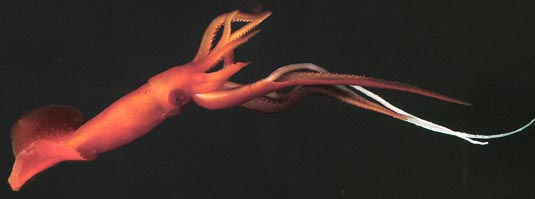
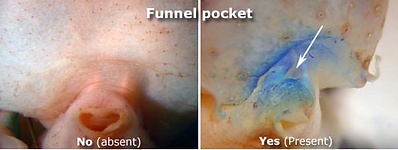
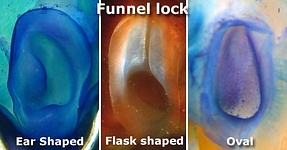




 Go to quick links
Go to quick search
Go to navigation for this section of the ToL site
Go to detailed links for the ToL site
Go to quick links
Go to quick search
Go to navigation for this section of the ToL site
Go to detailed links for the ToL site